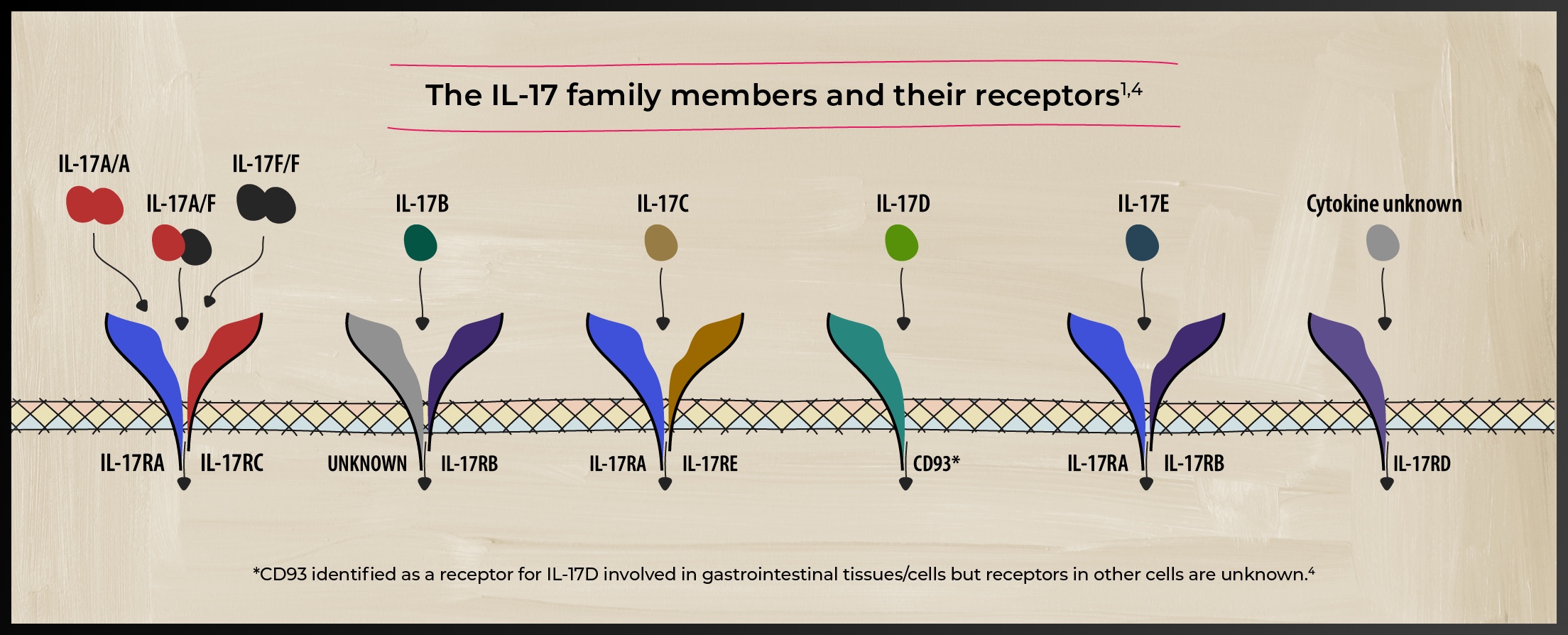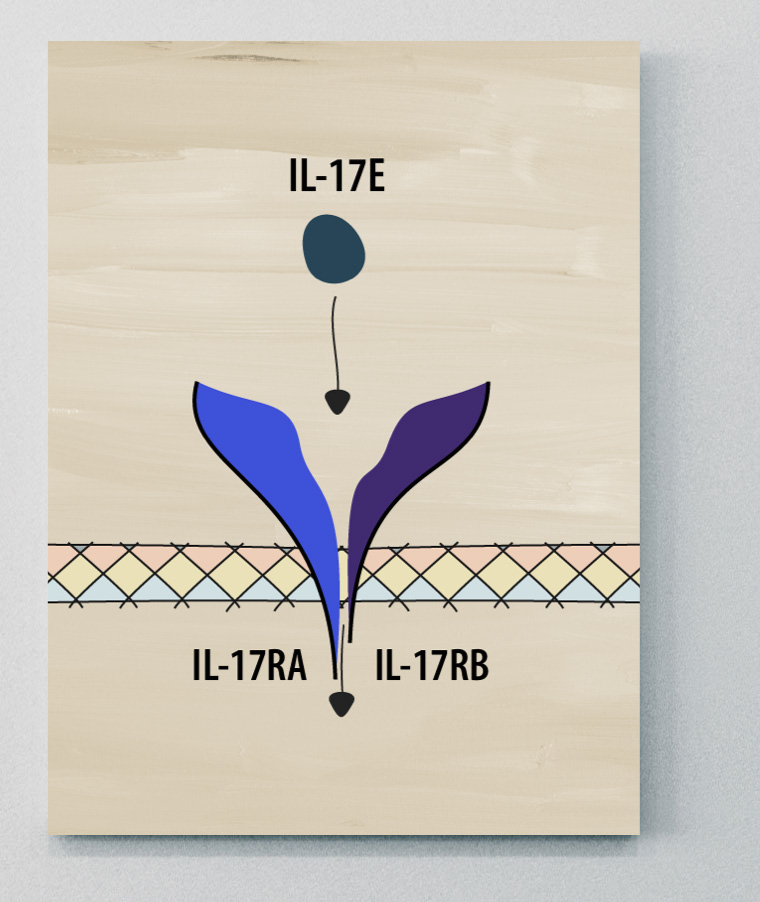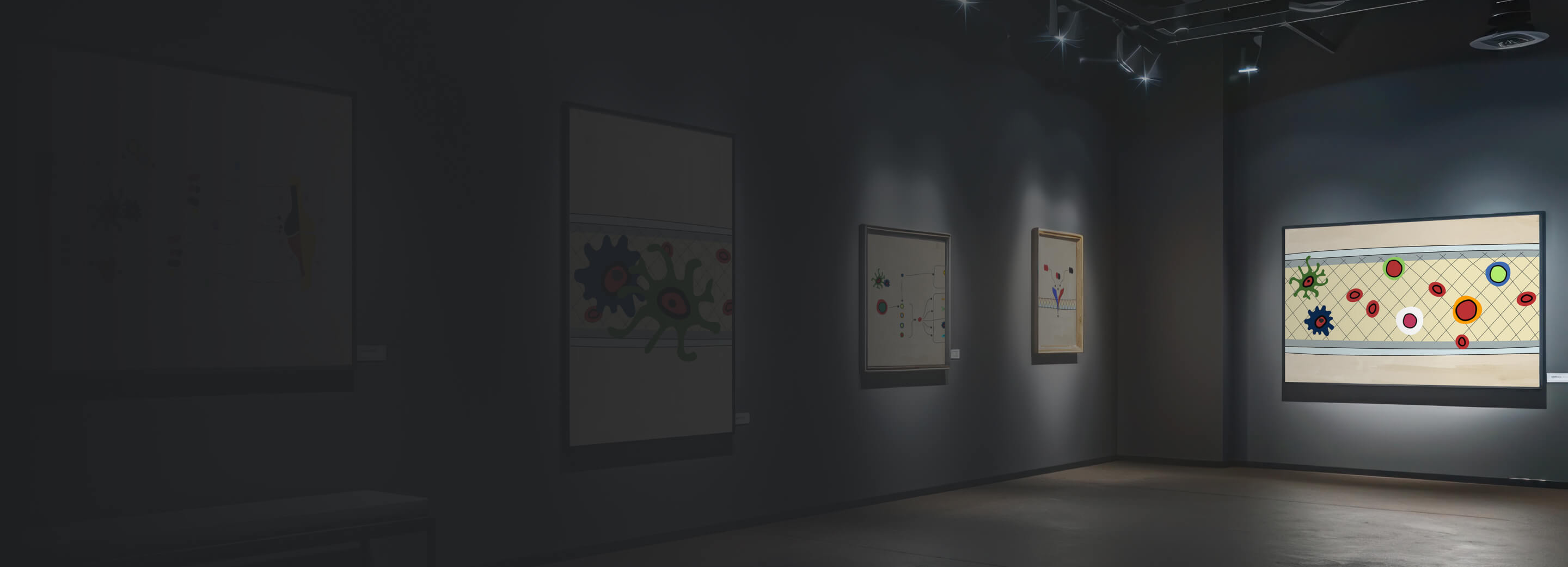

Explore the role of the IL-17 family in SpA and immune-mediated inflammatory diseases
IL-17=interleukin 17; SpA=spondyloarthritis.
The IL-17 family of cytokines
The IL-17 family of cytokines consists of 6 structurally related signaling molecules (IL-17A, IL-17B, IL-17C, IL-17D, IL-17E, and IL-17F) that play important roles in the immune system.1
IL-17 cytokines are secreted by a subset of T helper cells called Th17 cells, which are primarily driven by IL-23.2 However, IL-17 is also known to be expressed by a range of other adaptive and innate immune cells, which can be activated independently of IL-23 by cytokines such as IL-1β, IL-12, and IL-18.2-4

Most of the IL-17 family members function as pairs, consisting of 2 identical molecules (homodimers), but IL-17A and IL-17F can function as both homodimers (IL-17A/A and IL-17F/F) and heterodimers (IL-17A/F).1
Each IL-17 cytokine binds to 1 or more receptors on the surface of target cells, with IL-17A and IL-17F signaling through the same receptor complex. When an IL-17 molecule binds to its receptor, it triggers a series of events inside the cell, leading to changes in the cell’s behavior or function. Since IL-17A and IL-17F share the same receptor complex, they have overlapping roles.1,2,4


Understanding the role of the IL-17 cytokine family in disease
The IL-17 family of cytokines is involved in regulating many immune responses and play a key role in both health and disease. They have been strongly linked to the pathogenesis of many rheumatic diseases, including axSpA and PsA.3,5
Learn more about the role of IL-17 cytokines in disease
-

IL-17A3-7 | IL-17F3-7
- PsA, axSpA
- RA, SLE, PSO, HS
- Others (cancer, obesity, asthma, MS)
-

IL-17B5
- Inflammatory arthritis (RA)
- SLE
- Cancer
-

IL-17C5,8,9
- PSO, HS, SLE
- IBD
- Cancer
- Kidney disease
-

IL-17D5,10
- RA
- Cancer
- Sepsis
-

IL-17E2,5
- PSO
- Allergic responses (asthma)
Role of the IL-17 cytokines in SpA
IL-17A and IL-17F have a well-established role in the development of SpA. There is emerging evidence on the role of IL-17B, IL-17C, IL-17D, and IL-17E in immune-mediated inflammatory diseases; however, their role in SpA remains to be elucidated.3-10


IL-17A and IL-17F
Studies indicate that the biological activity and roles of IL-17A and IL-17F are similar, and distinct functions for IL-17F beyond those of IL-17A have not been identified to date.1,3
Both IL-17A and IL-17F mediate downstream pro-inflammatory responses in SpA; however, their roles may differ across different sites of inflammation.11
These differences may be due to differences in expression ratios across various sites of the body, differential regulation, and differences in potency.11 For example, although IL-17F is found at higher levels (up to 30-fold) in lesional skin and serum of patients with PSO, IL-17A has a more potent pro-inflammatory effect.3
IL-17A and IL-17F expression differs across sites of inflammation
-

Bone
(axSpA and PsA)- IL-17A and IL-17F have equal potency in promoting osteogenic differentiation11,12
- IL-17A and IL-17F can drive osteoproliferation in AS11,12
-

Peripheral and
axial enthesis- IL-17F was preferentially expressed over IL-17A in peripheral blood and enthesis13
- IL-17A and IL-17F are produced by entheseal T cells and synergize with TNF14
-

Skin
(PSO)- IL-17F expression is higher than IL-17A in PSO lesional skin, but IL-17A has a more potent effect11
-

Joint
(axSpA and PsA)- IL-17A expression is higher than IL-17F in SpA synovitis11
- IL-17F (but not IL-17A) expression is elevated in synovial tissue in PsA versus OA15
Summary of findings from pre-clinical and translational studies.
Studies suggest that IL-17A and IL-17F are drivers of inflammation and new bone formation12,16-18
IL-17A and IL-17F independently cooperate with TNF to drive inflammation by amplifying the production of IL-6 and IL-8 in synoviocytes16,17
IL-17A and IL-17F drive osteogenic differentiation of human mesenchymal stem cells*12,18


IL-17B
IL-17B mediates both pro- and anti-inflammatory responses. The role of IL-17B in SpA remains to be elucidated; however, IL-17B has a role in driving various immune-mediated inflammatory diseases, including RA and SLE.2,5
IL-17B is the primary IL-17 family cytokine in RA and OA tissues19
- In RA synovium, expression of IL-17B was significantly higher than IL-17D, IL-17E, and IL-17F (p<0.05)19
- In OA synovium and RA pannus, expression of IL-17B was significantly higher than all other IL-17 cytokines tested, including IL-17A, IL-17C, IL-17D, IL-17E, and IL-17F (p<0.05)19



IL-17C
IL-17C is involved in both pro- and anti-inflammatory responses. The inflammation incurred by IL-17C is often linked to the skin.2
IL-17C has been linked to the pathogenesis of PSO, HS, and IBD, as well as several other diseases and conditions. However, the role of IL-17C in SpA remains to be elucidated.2,5,8,9
The role of IL-17C and its receptor on skin and inflammation20,21
Studies have shown that IL-17C is expressed by activated keratinocytes in psoriatic skin and acts on its receptor on Th17 cells to propagate inflammation.20,21




IL-17D
IL-17D is the least well studied IL-17 family member, and its cellular sources and biological functions remain largely unknown. However, there is some evidence to suggest that IL-17D has a possible protective role in SpA.11


Studies suggest that IL-17D may also play a pro-inflammatory role in disease. In culture, IL-17D treatment stimulates the production of IL-6 and IL-8 cytokines, suggesting a potential role in mediating inflammation.23
While there is some evidence to suggest that IL-17D may have both a pro- and anti-inflammatory role, its pathogenic role in disease is unclear.3


IL-17E
IL-17E differs from other IL-17 members as it promotes type 2 immunity (associated with the development of allergic responses) and has varying roles in different tissues.24
IL-17E plays a pro-inflammatory role in Th2-mediated diseases and an anti-inflammatory role in other diseases. However, the role of IL-17E in SpA remains to be elucidated.24


Consider the clinical implications of the IL-17 family
IL-17A and IL-17F have established roles in driving SpA. Although they have overlapping functions, the role of IL-17A and IL-17F in SpA may differ across sites of inflammation.11
The role of the other IL-17 family members (including IL-17B, IL-17C, IL-17D, and IL-17E) in SpA is largely unknown; however, they have emerged as key drivers of other IMIDs.3,6
Future research on IL-17 cytokines may hold the key to therapeutic advances in SpA and a range of other diseases.
IMID=immune-mediated inflammatory diseases.


TAKE YOUR SEATS IN THE PATHOBIOLOGY LEARNING THEATRE
Uncover how IL-17A and IL-17F work in tandem to inhibit inflammation in SpA
Visit the axSpA or PsA pathobiology exhibit to uncover the mechanisms driving SpA
Explore the axSpA exhibit
Explore the PsA exhibit
Become a member of the RheuMuseum and be the first to know about new exhibits
Sign up to stay in the loop on new exhibits about clinical research, important updates, and other educational opportunities.
- Brembilla NC, Senra L, Boehncke WH. The IL-17 family of cytokines in psoriasis: IL-17A and beyond. Front Immunol. 2018;9:1682. doi:10.3389/fimmu.2018.01682
- Meehan EV, Wang K. Interleukin-17 family cytokines in metabolic disorders and cancer. Genes (Basel). 2022;13(9):1643. doi:10.3390/genes13091643
- Navarro-Compán V, Puig L, Vidal S, et al. The paradigm of IL-23-independent production of IL-17F and IL-17A and their role in chronic inflammatory diseases. Front Immunol. 2023;14:1191782. doi:10.3389/fimmu.2023.1191782
- Chung SH, Ye XQ, Iwakura Y. Interleukin-17 family members in health and disease. Int Immunol. 2021;33(12):723-729. doi:10.1093/intimm/dxab075
- Davydova A, Kurochkina Y, Goncharova V, et al. The interleukine-17 cytokine family: role in development and progression of spondyloarthritis, current and potential therapeutic inhibitors. Biomedicines. 2023;11(5):1328. doi:10.3390/biomedicines11051328
- McGeachy MJ, Cua DJ, Gaffen SL. The IL-17 family of cytokines in health and disease. Immunity. 2019;50(4):892-906. doi:10.1016/j.immuni.2019.03.021
- Koga T, Ichinose K, Kawakami A, et al. Current insights and future prospects for targeting IL-17 to treat patients with systemic lupus erythematosus. Front Immunol. 2021;11:624971. doi:10.3389/fimmu.2020.624971
- Fletcher JM, Moran B, Petrasca A, Smith CM. IL-17 in inflammatory skin diseases psoriasis and hidradenitis suppurativa. Clin Exp Immunol. 2020;201(2):121-134. doi:10.1111/cei.13449
- Nies JF, Panzer U. IL-17C/IL-17RE: emergence of a unique axis in TH17 biology. Front Immunol. 2020;11:341. doi:10.3389/fimmu.2020.00341
- Liu X, Sun S, Liu D. IL-17D: a less studied cytokine of IL-17 family. Int Arch Allergy Immunol. 2020;181(8):618-623. doi:10.1159/000508255
- Yeremenko N. Out of the shadow of interleukin-17A: the role of interleukin-17F and other interleukin-17 family cytokines in spondyloarthritis. Curr Opin Rheumatol. 2021;33(4):333-340. doi:10.1097/BOR.0000000000000805
- Wang R, Maksymowych WP. Targeting the interleukin-23/interleukin-17 inflammatory pathway: successes and failures in the treatment of axial spondyloarthritis. Front Immunol. 2021;12:715510. doi:10.3389/fimmu.2021.715510
- Mcdermott N, Macleod T, Rao AS, et al. AB0011 cytometric analysis of activated entheseal tissue resident T-cells reveals IL-17F as the dominant IL-17 isoform expressed by innate and adaptive lymphocytes. Annals of the Rheumatic Diseases. 2023;82:1184-1185
- Bridgewood C, Russell T, Watad A, et al. THU0013 IL-17A and IL-17F are secreted by enthesis T cells and synergize with TNF to induce CCL20 from entheseal stromal cells. Annals of the Rheumatic Diseases. 2019;78:274
- Taams LS, Steel KJA, Srenathan U, et al. IL-17 in the immunopathogenesis of spondyloarthritis. Nat Rev Rheumatol. 2018;14(8):453-466. doi:10.1038/s41584-018-0044-2
- Sánchez-Rodríguez G, Puig L. Pathogenic role of IL-17 and therapeutic targeting of IL-17F in psoriatic arthritis and spondyloarthropathies. Int J Mol Sci. 2023;24(12):10305. doi:10.3390/ijms241210305
- Noack M, Beringer A, Miossec P. Additive or synergistic interactions between IL-17A or IL-17F and TNF or IL-1β depend on the cell type. Front Immunol. 2019;10:1726. doi:10.3389/fimmu.2019.01726
- Croes M, Öner FC, van Neerven D, et al. Proinflammatory T cells and IL-17 stimulate osteoblast differentiation. Bone. 2016;84:262-270. doi:10.1016/j.bone.2016.01.010
- Kouri VP, Olkkonen J, Ainola M, et al. Neutrophils produce interleukin-17B in rheumatoid synovial tissue. Rheumatology (Oxford). 2014;53(1):39-47. doi:10.1093/rheumatology/ket309
- Johnston A, Fritz Y, Dawes SM, et al. Keratinocyte overexpression of IL-17C promotes psoriasiform skin inflammation. J Immunol. 2013;190(5):2252-2262. doi:10.4049/jimmunol.1201505
- Maggi L, Santarlasci V, Capone M, et al. Distinctive features of classic and nonclassic (Th17 derived) human Th1 cells. Eur J Immunol. 2012;42(12):3180-3188. doi:10.1002/eji.201242648
- Chen S, Manning C, van Tok M, et al. Interleukin-17D, a cytokine derived from stromal cells, attenuates joint inflammation [abstract]. Arthritis Rheumatol. 2020;72(suppl 10). Accessed March 2024. https://acrabstracts.org/abstract/interleukin-17d-a-cytokine-derived-from-stromal-cells-attenuates-joint-inflammation/
- Starnes T, Broxmeyer HE, Robertson MJ, et al. Cutting edge: IL-17D, a novel member of the IL-17 family, stimulates cytokine production and inhibits hemopoiesis. J Immunol. 2002;169(2):642-646. doi:10.4049/jimmunol.169.2.642
- Deng C, Peng N, Tang Y, et al. Roles of IL-25 in type 2 inflammation and autoimmune pathogenesis. Front Immunol. 2021;12:691559. doi:10.3389/fimmu.2021.691559
- Fort MM, Cheung J, Yen D, et al. IL-25 induces IL-4, IL-5, and IL-13 and Th2-associated pathologies in vivo. Immunity. 2001;15(6):985-995. doi:10.1016/s1074-7613(01)00243-6